We may not have the course you’re looking for. If you enquire or give us a call on + 1-866 272 8822 and speak to our training experts, we may still be able to help with your training requirements.
Training Outcomes Within Your Budget!
We ensure quality, budget-alignment, and timely delivery by our expert instructors.
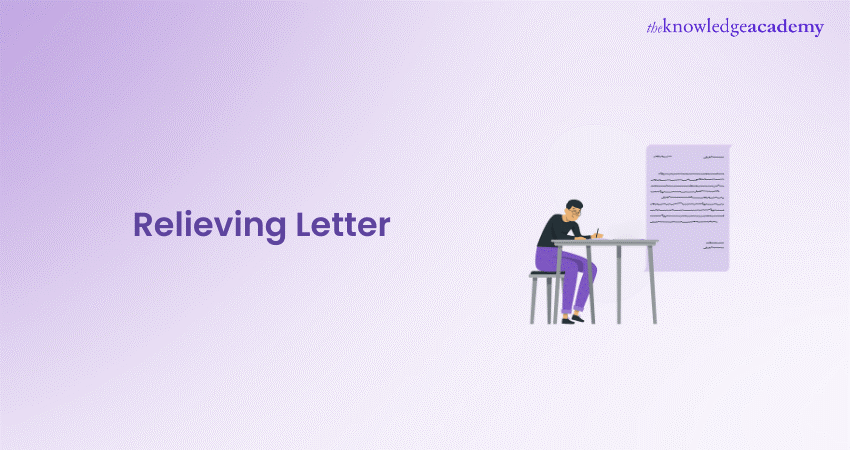
Leaving a job is like closing a chapter in one's career story, and a Relieving Letter is the final signature on that page. More than a formality, it's a golden ticket ensuring an employee's smooth transition from one step of their financial trajectory to another.
This blog explores everything about Relieving Letters, ensuring you're fully equipped to say a proper farewell to an employee. Read on and explore the best formats to follow while writing a Relieving Letter.
Table of Contents
1) What is a Relieving Letter?
2) Importance of Relieving Letter
3) Format of Relieving Letter
4) How to Write a Relieving Letter?
5) Relieving Letter Templates
6) Conclusion
What is a Relieving Letter?
A Relieving Letter is an official document given by an employer to an employee who is departing from the company or resigning from their position. It serves as a full and final settlement that provides proof of the employee’s termination or resignation and specific details about their employment.
A relief letter is submitted when an employee steps ahead of another company in achieving the goals. It is mainly required when a person wants to switch companies to achieve a goal, prepare for higher education, or move abroad.
The Relieving Letter has content that proves the candidate has completed all his required tasks and services with their previous employer. The employees must submit a Relieving Letter to the new employers while switching jobs.
Importance of Relieving Letter
A Relieving Letter is important because it releases employees from their responsibility to the company and acknowledges their intent to leave. Written documentation of a company accepting an employee's resignation can be necessary if either party needs to reference the paperwork later. It provides a formal end to the employee's service and offers proof that the company has accepted the employee's notice.
When the employee receives a new job opportunity, their new employer may ask for written confirmation of their exit from their previous position. The letter can show the new employer there were no issues with the employee's departure. It can also show that the employee has no commitment to their former employer.
Format of Relieving Letter
A Relieving Letter’s tone must be professional, and the content should be concise. Given that the employer’s name is included in the document, the employer should ensure the document’s draft is done appropriately. Here are the important components of the format of a Relieving Letter:
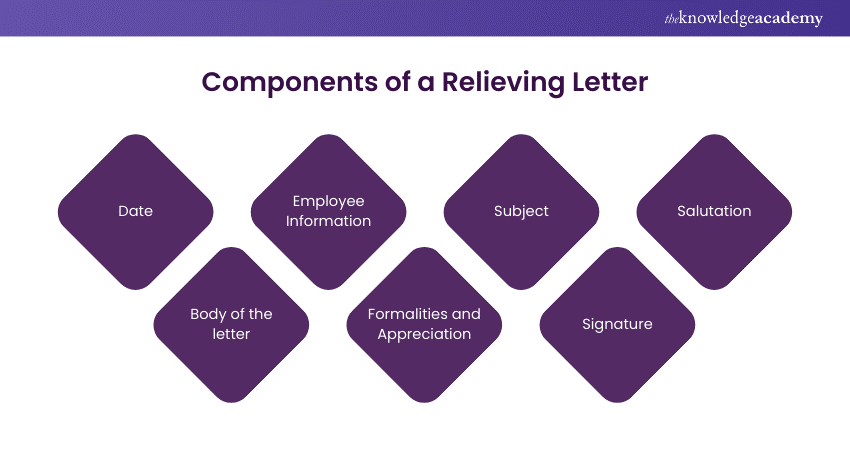
1) Date: The issuance date is the first section, and it must be written at the top of the page. The date can be critical in case of any disputes.
2) Employee Information: The employee information, along with the name, designation, and department, is put below the date of issuance. The company’s name can also be put in this section.
3) Subject: This section offers a brief about the letter’s purpose.
4) Salutation: In this section, the letter’s recipient is addressed by their first name preceded by a formal salutation. For example, ‘Dear [First Name]’.
5) Body of the Letter: This section outlines particulars about the employee’s resignation along with the fact that the employer has accepted it. Also, it includes the date the employee resigned and the last day of employment.
6) Formalities and Appreciation: In this section, the employer provides assurance that the employee will receive full and final settlement after a particular period. This is followed by thanks and wishes for the employee.
7) Signature: The signature on the bottom left section of the page marks the end of the letter.
Explore the world of Talent Management and Employee Management in our comprehensive HR Strategy Training – Sign up now!
How to Write a Relieving Letter?
Here are some steps you can take to write an effective Relieving Letter:
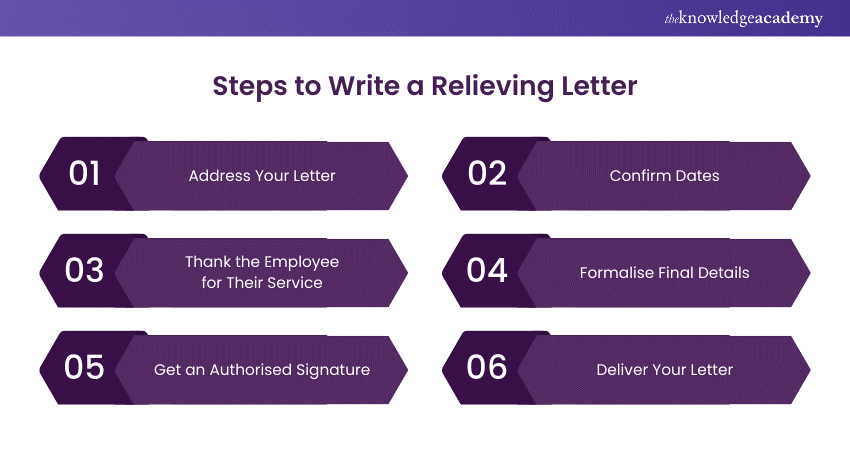
1) Address Your Letter: Addressing your letter can ensure its authenticity and formality. Choose a paper that displays the company's business information and letterhead. Write the employee's full name and any identifying information you need, such as their full name, ID number and address. Be sure to include the date and a subject line that describes the letter's content. You can also include these elements in a virtual letter or email.
2) Confirm Dates: Include the essential dates involving the employee's resignation in your letter. This includes the day the employee gave their resignation letter and the last day of their employment. Doing so can ensure you have written documentation of every date relevant to their departure from the company.
3) Thank the Employee for Their Service: Some employees show future employers their Relieving Letter as proof they left their previous position with no issues. By thanking the employee for their service to the company, you show your appreciation for the work they provided and confirm they followed resignation procedures successfully. If there were issues with an employee's resignation, like a delayed receipt of equipment, be sure to document these elsewhere.
4) Formalise Final Details: Your letter can include the final details of the employee's last paycheque, payout or settlement. Explain the timeline they can expect to see the money and how they can expect to receive it. This helps the employee plan for their reimbursement and confirms your intent to fulfil the terms of their settlement.
5) Get an Authorised Signature: A company's HR department typically provides an employee with a Relieving Letter. In these instances, have the HR manager sign the letter and keep a copy in the employee's file. If an HR signature isn't available, have someone authorised within the company, like a senior manager or executive team member, sign the letter.
6) Deliver Your Letter: Deliver your letter to the employee on the last day of employment. Make two copies of the letter, one to give to the employee and one to keep in the employee's file. You may also want to keep a digital backup copy of the letter.
Learn the importance of supporting HR Managers in our comprehensive Certified HR Advisor Course – Sign up now!
Relieving Letter Templates
Now that you know the basics of a Relieving Letter, it's essential to go through some examples to gain a broader understanding. Below, we have curated three sample formats for Relieving Letters for Digital Marketing Executives, Teachers, and Managers.
Relieving Letter Template for a Digital Marketing Executive
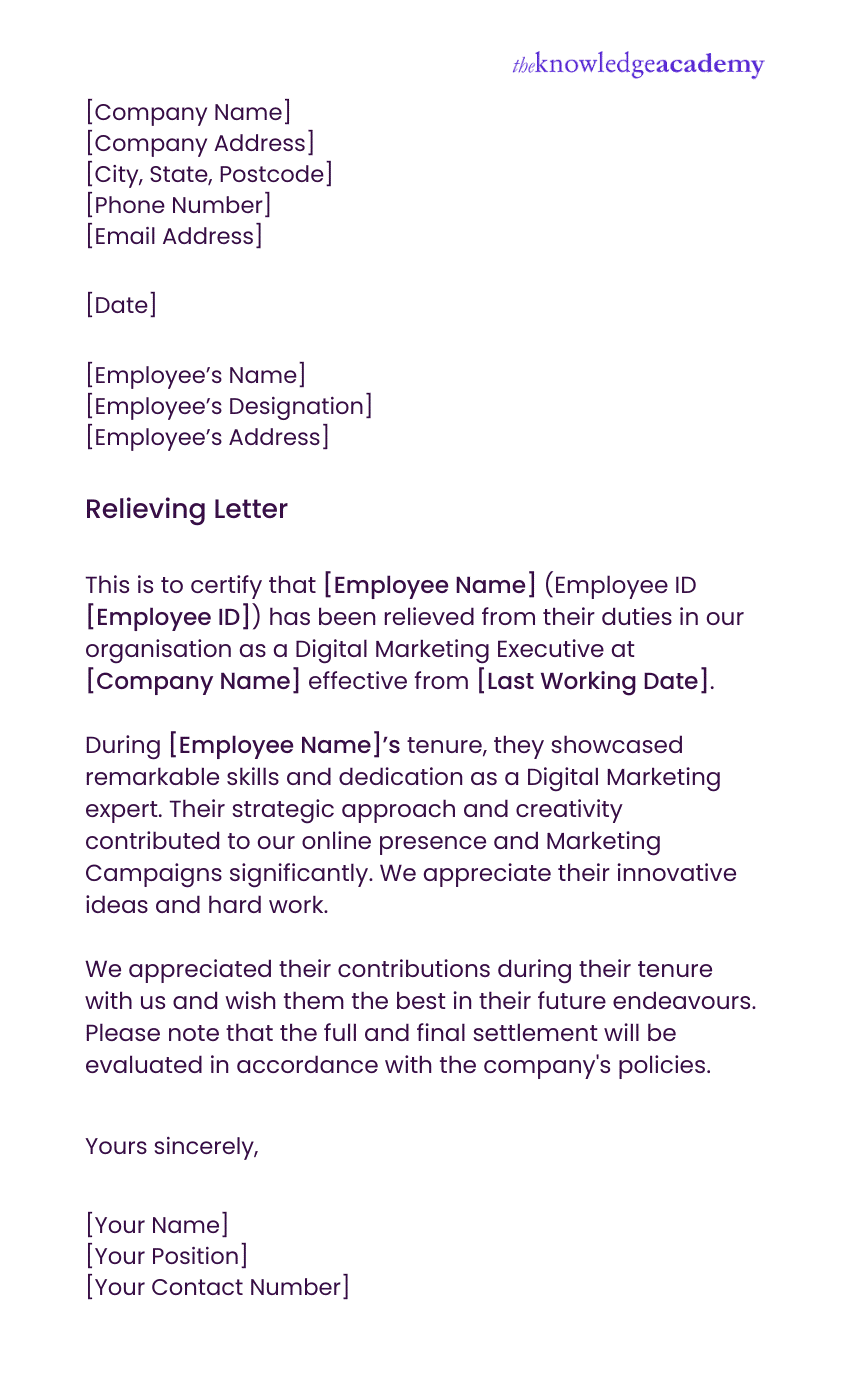
Relieving Letter Template for Teachers
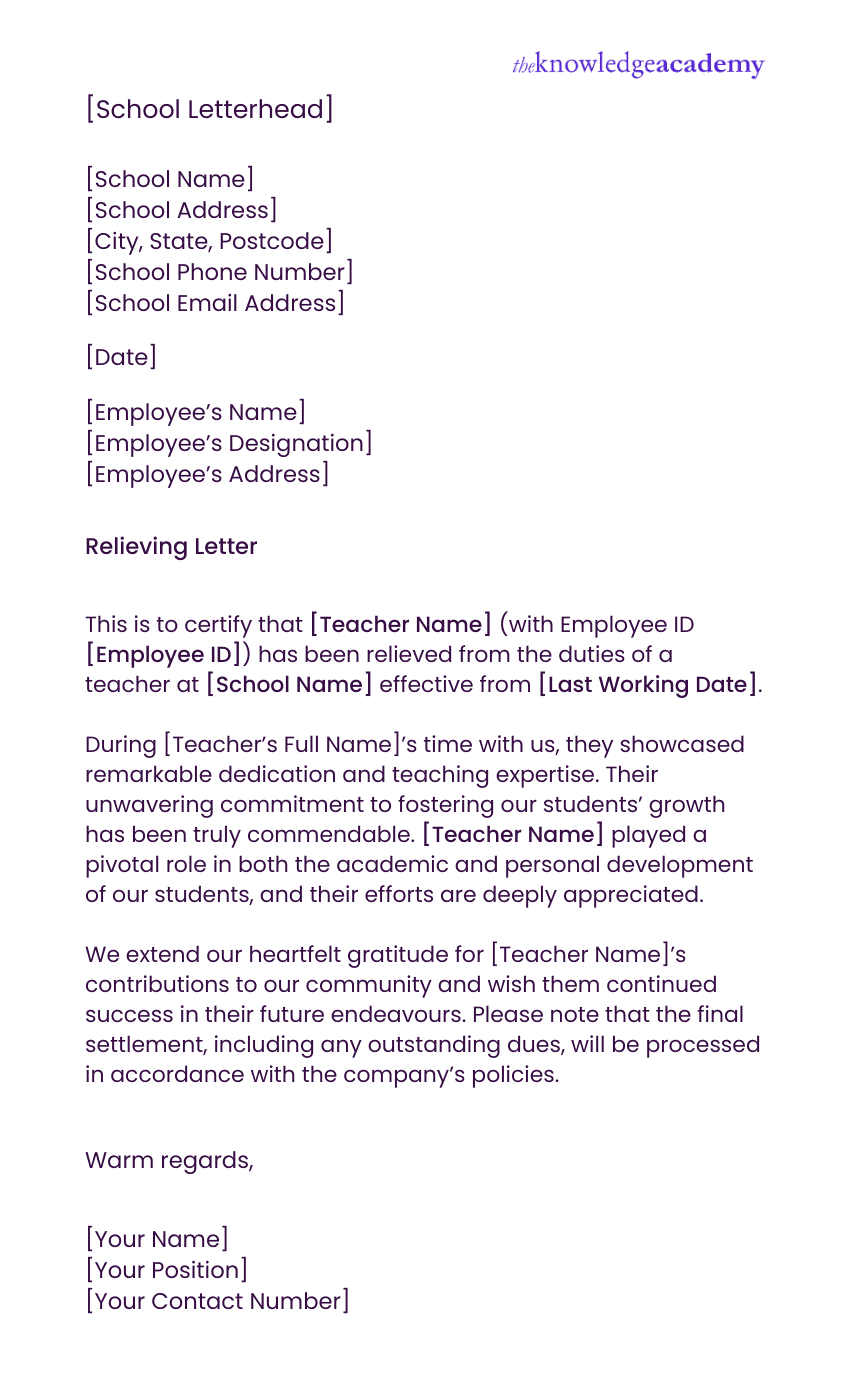
Relieving Letter Template for a Manager
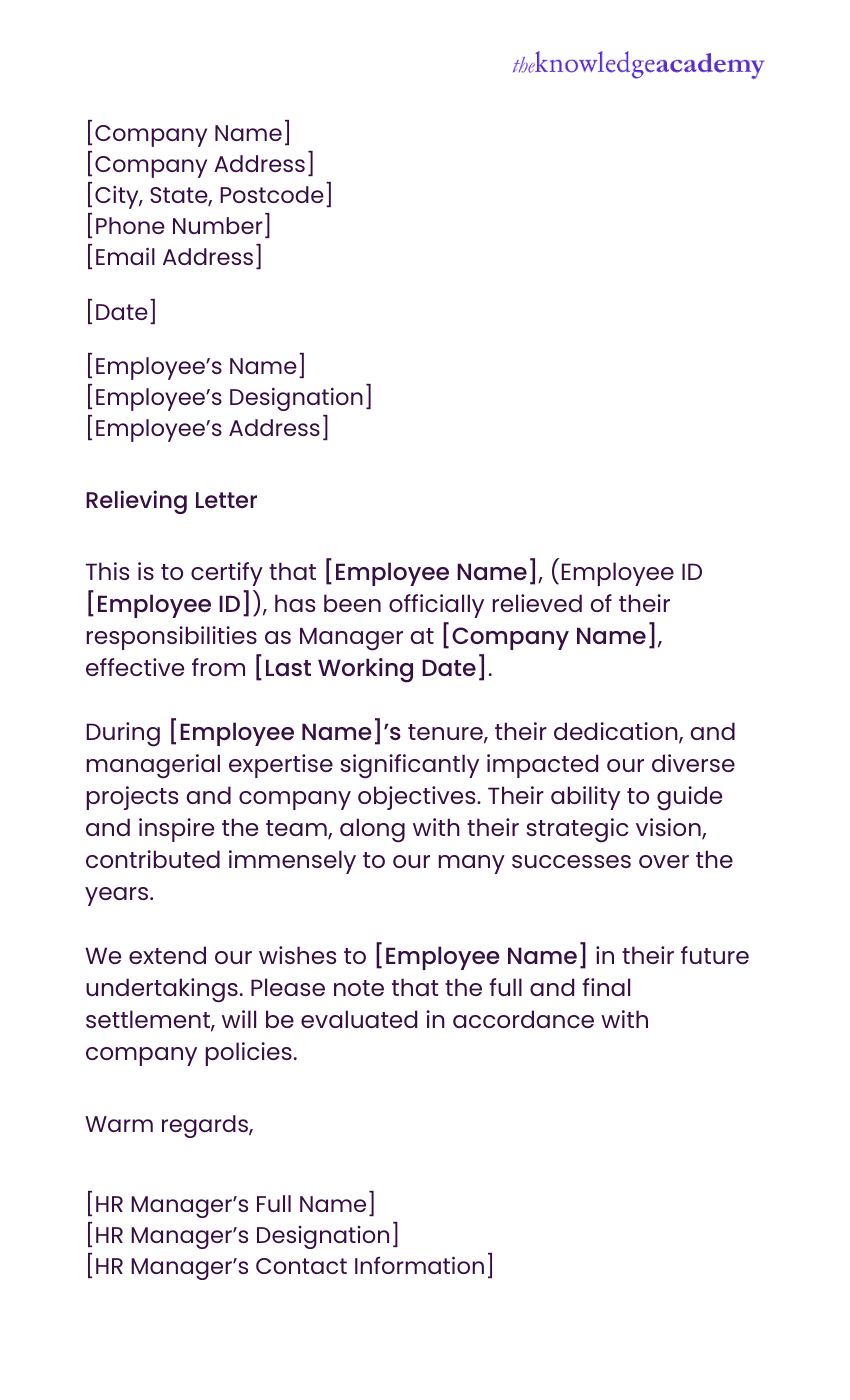
Conclusion
In conclusion, a Relieving Letter is a crucial document that marks the official end of one's employment. Ensuring that it's accurate and well-structured not only functions as an amicable farewell but also benefits future job prospects for the employee. We hope this blog helps you gain deeper insight into the art of writing the ideal Relieving Letter.
Enhance your understanding of Performance Management with our Certified HR Manager Course - Sign up now!
Frequently Asked Questions

An employer issues a termination letter to notify employees that their employment is officially terminated. The letter outlines the reasons and details of termination. A Release Letter confirms that an employee has been released from their duties, often after a resignation or the end of a contract.

Although not explicitly mentioned, you should sign a resignation letter. Signatures are accepted in handwriting only, so the normal procedure is to type a letter, print it, then sign it and deliver it.

The Knowledge Academy takes global learning to new heights, offering over 30,000 online courses across 490+ locations in 220 countries. This expansive reach ensures accessibility and convenience for learners worldwide.
Alongside our diverse Online Course Catalogue, encompassing 17 major categories, we go the extra mile by providing a plethora of free educational Online Resources like News updates, Blogs, videos, webinars, and interview questions. Tailoring learning experiences further, professionals can maximise value with customisable Course Bundles of TKA.

The Knowledge Academy’s Knowledge Pass, a prepaid voucher, adds another layer of flexibility, allowing course bookings over a 12-month period. Join us on a journey where education knows no bounds.

The Knowledge Academy offers various HR Leadership Courses, including the Certified HR Manager Course and the HR Analytics Course. These courses cater to different skill levels, providing comprehensive insights into Employee Benefits.
Our HR Blogs cover a range of topics related to Human Resources, offering valuable resources, best practices, and industry insights. Whether you are a beginner or looking to advance your HR skills, The Knowledge Academy's diverse courses and informative blogs have got you covered.







 Top Rated Course
Top Rated Course




 If you wish to make any changes to your course, please
If you wish to make any changes to your course, please


